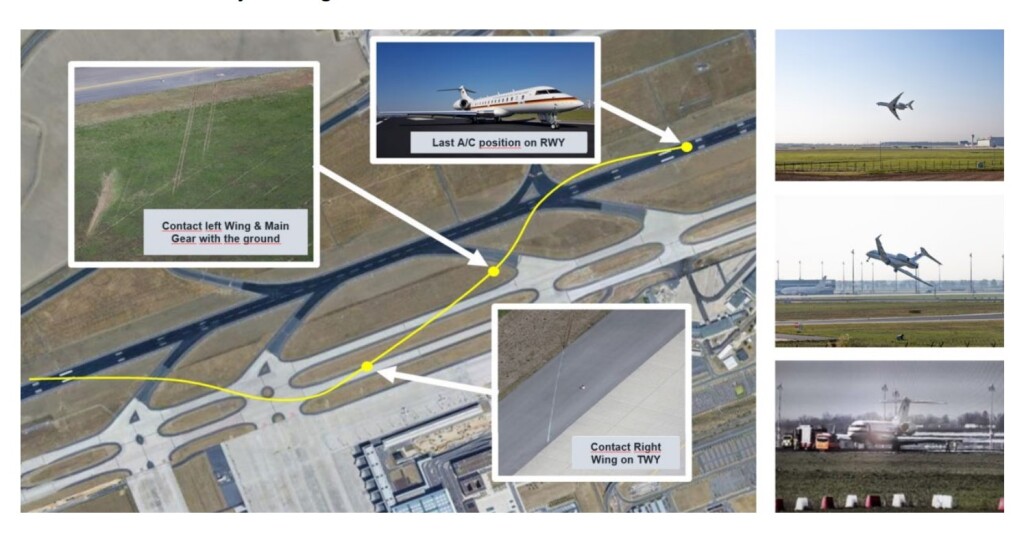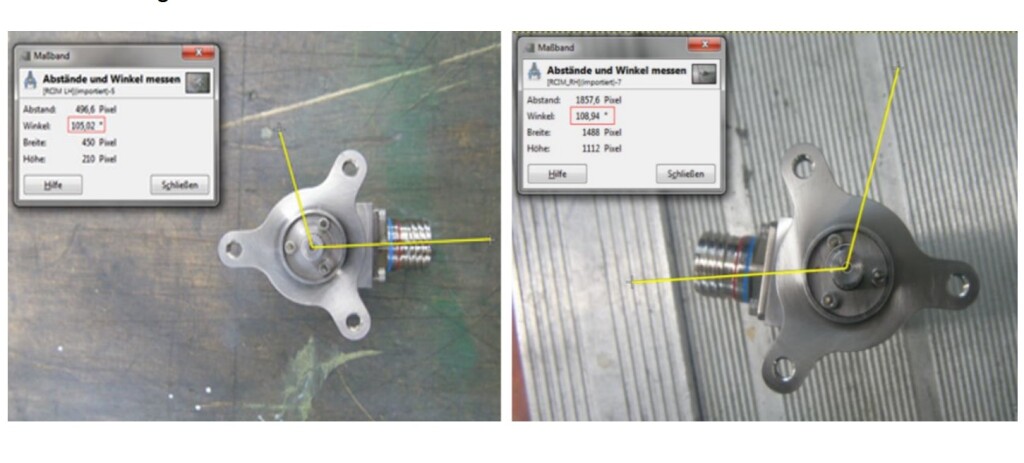Luftwaffe VVIP Global 5000 14+01 Written Off After Flying Control Assembly Error
On 16 April 2019 Luftwaffe VVIP Bombardier BD-700-1A11 Global 5000 14+01 departed Berlin-Schönefeld (BER) for Cologne-Bonn (CGN) on its first flight after having undergone heavy maintenance by Lufthansa Bombardier Aviation Services (LBAS).
The aircraft climbed to c 21000 ft but suffered flight control problems. The aircraft returned to Berlin-Schönefeld but suffered severe roll instability and the both wing tips reportedly struck the runway. Some reports suggest the aircraft was exposed to 5g manoeuvres. The aircraft has now been assessed as write off due to the damage sustained.

Luftwaffe Bombardier Global 5000 14+01 Flight at Berlin-Schönefeld, 16 April 2019 (Credit: Directorate of Aviation Safety Bundeswehr)
In December 2019 the Luftwaffe said that:
As part of the work, a component of the flight control system was replaced. An error in the setting of so-called signal transducers in conjunction with a lack of care in the function verification resulted in a malfunction in the flight control.
Other reports suggest a torque tube assembly was misassembled.
UPDATE 9 October 2020: Transport Canada have issued Airworthiness Directive CF-2020-35: Flight Controls – Roll Control Input-Modules (RCIMs) Incorrect Installation which states:
There are several in-service reports of a single RCIM being installed incorrectly, and one report of both RCIMs being installed incorrectly. An investigation has determined that it is physically possible for an RCIM to be installed and zeroed 180 degrees from its intended (design) installation orientation. If both RCIMs are installed incorrectly in the same manner, a misrigging condition occurs causing the multi-function spoilers (MFSs) to deploy opposite to the roll command. Misrigging of the MFS in this manner could lead to loss of control of the aeroplane.
To reduce the likelihood of incorrect RCIM installation during maintenance, the Aircraft Maintenance Manual (AMM) has been revised with improved RCIM installation and adjustment tasks. These improved tasks provide additional guidance to ensure proper orientation of the RCIM. A new AMM functional test task was introduced to improve the robustness of post-maintenance checks to confirm proper installation of the RCIMs. This AD requires the use of these latest AMM procedures when performing maintenance involving one or both RCIMs.
It is not clear if this AD is relevant to the Berlin-Schönefeld incident.
UPDATE 20 October 2022: It has been brought to our attention that a summary of the Directorate of Aviation Safety Bundeswehr (DASBw) report has been made public and confirms the involvement of the MFS and RCIMs. Their findings were:
- Based upon the design of the system, the possibility exists, that an improperly installed and adjusted element of the FCS can pass an operational test, without generating a failure message.
- The maintenance company performed routine maintenance.
- During the course of the routine maintenance a malfunction of an element of the FCS was determined which required troubleshooting.
- In the completion of the troubleshooting and operational checks, the abnormal operation of the MFS was not recognized.
- The aircraft was deemed “ready for flight” and transferred to the flight crew.
- Prior to takeoff, while completing the flight control checks on the ground, the AC did not recognize the abnormal operation of the MFS.
- Shortly after takeoff, the crew recognized a problem in the flight controls and decided to return to Berlin-Schönefeld for landing.
- While flying with under the command of the autopilot, while attempting a left hand turn, the aircraft rolled towards the right and entered a steep uncommanded dive.
- The aircraft was recovered and brought back to a stable flight condition. The crew sought an expedient landing at Berlin-Schönefeld.
- During the final phase of the approach and landing, the aircrew experienced control difficulties resulting in ground contact of both wings, prior to the aircraft settling on the main gear.
- After touching down in the grass, the PF was able to steer the aircraft back towards the paved surface and eventually bring it to a stop on the runway.
- The crew was uninjured, and egressed the aircraft under their own power. The aircraft was severely damaged.
They summarise that:
The…accident…was the result of a series of omissions and errors that originated in different core areas, and involved many people either directly or indirectly.
The technical error that occurred during the installation and adjustment procedure of the RCIMs represents the event triggering the accident. The system design further enabled this failure, which allowed the RCIMs to be installed and adjusted in such a manner that the MFS functioned opposite of the corresponding input, and generated no error messages on the EICAS or the PMAT. Since the maintenance crew relied solely upon the EICAS warnings and the results given by the PMAT, the error remained undetected in the tests following the installation.
Bombardier Global 5000 Roll Control Input Module (RCIM) Can Be Installed and Zeroed at 180 degrees from their Intended Orientation (Credit: Directorate of Aviation Safety Bundeswehr)
Finally, as a last chance for accident prevention, the installation errors could have been recognized and identified by the PF through the accomplishment of a thorough flight control check.
In conclusion, the faulty installation and adjustment of the RCIMs created an unforeseen error, which was detectable, but went unnoticed and lead to a major aircraft accident. Precisely because such an error could remain undetected, despite many established safety control mechanisms, demanded a full-scale flight safety investigation.
Safety Resources
We also have written:
- Professor James Reason’s 12 Principles of Error Management
- Back to the Future: Error Management
- Safety Performance Listening and Learning – AEROSPACE March 2017
- Maintenance Human Factors: The Next Generation
- Airworthiness Matters: Next Generation Maintenance Human Factors
- Rockets Sleds, Steamships and Human Factors: Murphy’s Law or Holt’s Law?
- Critical Maintenance Tasks: EASA Part-M & -145 Change
Plus:
- ERJ-190 Flying Control Rigging Error
- B1900D Emergency Landing: Maintenance Standards & Practices
- Misassembled Anti-Torque Pedals Cause EC135 Accident
- EC130B4 Accident: Incorrect TRDS Bearing Installation
- Fatal $16 Million Maintenance Errors
- Insecure Pitch Link Fatal R44 Accident
- United Airways Suffers from ED (Error Dysfunction)
- USAF RC-135V Rivet Joint Oxygen Fire: A military accident investigation has paradoxically determined that a $62.4mn fire was due to a maintenance error but that no human factors were involved.
- Inadequate Maintenance, An Engine Failure and Mishandling: Crash of a USAF WC-130H
- Inadequate Maintenance at a USAF Depot Featured in Fatal USMC KC-130T Accident
- USAF F-16C Crash at Joint Base Andrews: Engine Maintenance Error
- USAF Engine Shop in “Disarray” with a “Method of the Madness”: F-16CM Engine Fire
- Contaminated Oxygen on ‘Air Force One’ Poor standards at a Boeing maintenance facility resulted in contamination of two oxygen systems on a USAF Presidential VC-25 (B747).
- USAF Tool Trouble: “Near Catastrophic” $25mn E-8C FOD Fuel Tank Rupture
- C-130 Fireball Due to Modification Error
- ‘Crazy’ KC-10 Boom Loss: Informal Maintenance Shift Handovers and Skipped Tasks
- Glider Controls Fail After Non Compliant Maintenance Embodying an AD
- ATR72 VH-FVR Missed Damage: Maintenance Lessons
- Dash 8 Q400 Return to Base After Pitot System Contaminated By Unapproved Test Kit Lubricant
- BFU Report on Dramatic Challenger Wake Vortex Accident
- UPDATE 8 April 2020: NTSB Confirms United Airlines Maintenance Error After 12 Years
- UPDATE 9 May 2020: Ungreased Japanese AS332L Tail Rotor Fatally Failed
- UPDATE 16 June 2020: CRJ-200 Landing Incident Highlighted US Maintenance Competency Inadequacies
- UPDATE 15 March 2021: ATR 72 Rudder Travel Limitation Unit Incident: Latent Potential for Misassembly Meets Commercial Pressure
FSF Maintenance Observation Programme (MOP)
Aerossurance worked with the Flight Safety Foundation (FSF) to create a Maintenance Observation Program (MOP) requirement for their contractible BARSOHO offshore helicopter Safety Performance Requirements to help learning about routine maintenance and then to initiate safety improvements:
 Aerossurance can provide practice guidance and specialist support to successfully implement a MOP.
Aerossurance can provide practice guidance and specialist support to successfully implement a MOP.




Recent Comments